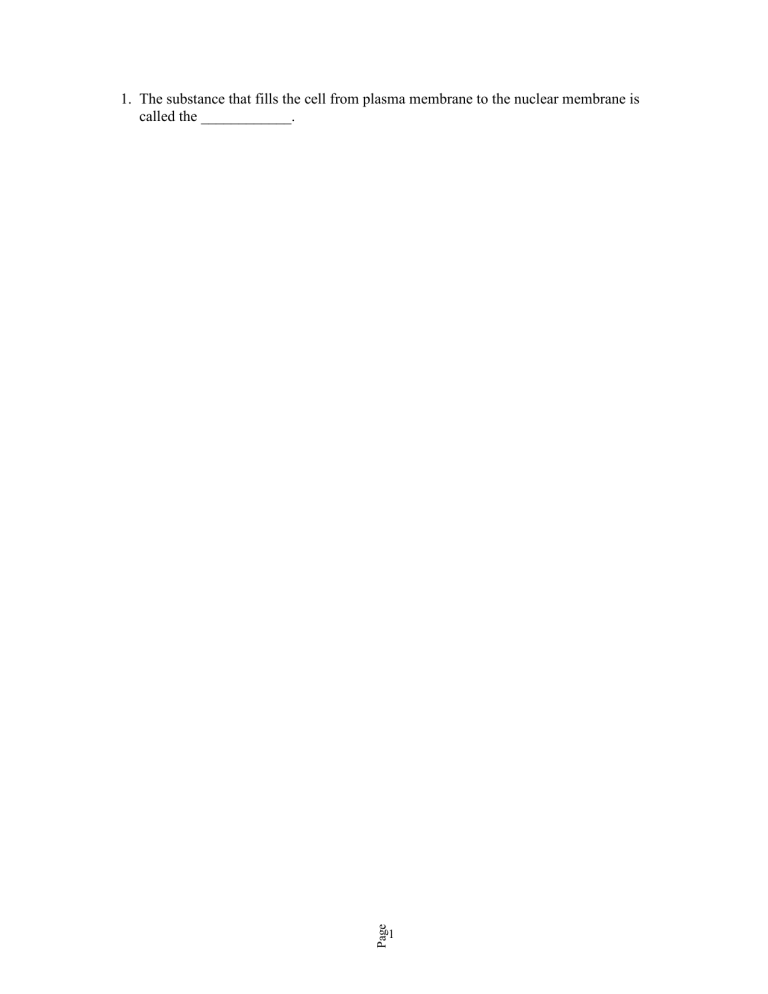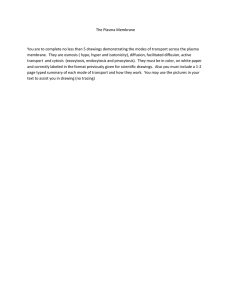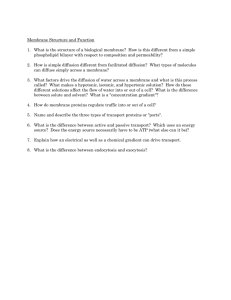Chapter-03
advertisement

Page 1. The substance that fills the cell from plasma membrane to the nuclear membrane is called the ____________. 1 Page 2 Page 2. A long, whiplike projection from the cell used in locomotion is a(n) ______________. 3 Page 4 Page 3. Small hairlike projections from the cell are called ___________. 5 Page 6 Page 4. The organelle that contains digestive enzymes is the ____________. 7 Page 8 Page 5. The large organelle that is the control center of the cell is the ___________. 9 Page 10 Page 6. In the pairing of bases in DNA, adenine pairs with __________. 11 Page 12 Page 7. The substance that makes up the genes is ________________. 13 Page 14 Page 8. In the pairing of bases in RNA, adenine pairs with ___________. 15 Page 16 Page 9. The type of RNA that carries amino acids to the ribosome is __________. 17 Page 18 Page 10. The process of synthesizing proteins based on an mRNA template is called ____________. 19 Page 20 Page 11. The period between one cell division and the next is called ________. 21 Page 22 Page 12. The process by which specialized cells engulf large particles is _____________. 23 Page 24 Page 13. The diffusion of water through a semipermeable membrane is ______________. 25 Page 26 Page 14. Passage of a solution through a membrane under mechanical force is called ___________. 27 15. A solution that has a lower concentration than the fluid within the cell is termed ___________. 16. A cell placed in a _______________ solution will swell. 17. The percentage salt in a normal saline solution is _____________. 18. A change in the genetic material of a cell is called a(n) ______________. 19. A personal characteristic or lifestyle habit that increases one's chances of getting cancer is called a(n) ______________. 20. A prefix meaning same is ________. Page 21. The metric unit used for microscopic measurement is the A) me ter B) mi cro me ter C) ce nti me ter D) kil om ete r 28 Page 22. The microscope with the highest magnification is the A) sca nni ng ele ctr on mi cro sco pe B) tra ns mi ssi on ele ctr on mi cro sco pe C) co mp ou nd lig ht mi cro sco pe D) si mp le lig ht mi cro sco pe 29 Page 23. The plasma membrane is best described as A) sol id B) per me abl e C) sel ect ive ly per me abl e D) hy pot oni c 30 Page 24. The major lipids in the plasma membrane are A) pro tei ns an d ph os ph oli pid s B) car bo hy dra tes an d pro tei ns C) ph os ph oli pid s an d ch ole ste rol D) cal ciu m sal ts an d ph os ph oli pid 31 s 25. Which of the following membrane proteins changes shape to move substances across the plasma membrane? A) ch an nel B) rec ept or C) en zy me D) tra ns por ter Page 26. Which of the following membrane proteins attaches cells to other cells? A) ch an nel B) lin ker C) cel l ide ntit y ma rke r D) tra ns por ter 32 27. The small body in the nucleus that assembles ribosomes is called the A) nu cle olu s B) mit oc ho ndr ion C) ce ntr iol e D) en do pla sm ic reti cul um Page 28. An organelle that produces energy for the cell is called a(n) A) rib os om e B) mit oc ho ndr ion C) Go lgi ap par atu s D) nu cle olu s 33 29. Small bodies involved in the manufacture of proteins are A) rib os om es B) nu cle oli C) mit oc ho ndr ia D) ce ntr iol es Page 30. If a cell lacked centrioles, it would not be able to A) sy nth esi ze pro tei ns B) sy nth esi ze R N A C) div ide D) sec ret e pro tei ns 34 Page 31. A particular cell type specializes in breaking down harmful by-products of metabolism. This cell type would contain very high levels of A) lys os om es B) en do pla sm ic reti cul um C) ce ntr iol es D) per oxi so me s 35 32. Two cells vary in the amount of energy they require. One cell, a muscle cell, must generate large supplies of ATP. The other cell, a skin cell, requires very little ATP. Based solely on information provided in this question, these two cells would differ in the abundance of A) mit oc ho ndr ia B) lys os om es C) ves icl es D) Go lgi ap par atu s Page 33. A nucleotide contains a nitrogen base, a sugar unit, and a A) ph os ph ate uni t B) gly cer ol C) fatt y aci d D) pro tei n uni t 36 34. The RNA found in ribosomes is called A) rR N A B) m R N A C) tR N A D) sR N A Page 35. Ribosomes participate in the process of A) D N A sy nth esi s B) tra nsc rip tio n C) tra nsl ati on D) mu tati on 37 Page 36. Transcription is the synthesis of A) R N A B) pro tei n C) lipi ds D) car bo hy dra tes 38 Page 37. The correct order of the stages in mitosis is A) an ap has e, tel op has e, me tap has e, pro ph ase B) pro ph ase , me tap has e, an ap has e, tel op has e C) pro ph ase , an ap has e, tel op has e, me tap 39 has e D) tel op has e, an ap has e, pro ph ase , me tap has e Page 38. The phase of mitosis when the chromosomes pull apart is A) int erp has e B) tel op has e C) an ap has e D) me tap has e 40 39. The phase of mitosis during which the chromosomes condense is A) an ap has e B) pro ph ase C) me tap has e D) int erp has e Page 40. Droplets of fluid are taken in by the cell using the process of A) dif fus ion B) pin oc yto sis C) ex oc yto sis D) act ive tra ns por t 41 41. What effect does diffusion usually have on the concentration gradient? A) inc rea se B) de cre ase C) no ch an ge D) No ne of the ans we rs are cor rec t. Page 42. Which of the following processes requires ATP? A) os mo sis B) dif fus ion C) act ive tra ns por t D) fac ilit ate d dif fus ion 42 43. Which of the following processes moves a substance that can freely pass through the plasma membrane? A) si mp le dif fus ion B) fac ilit ate d dif fus ion C) act ive tra ns por t D) ph ag oc yto sis Page 44. Cells shrink when they are placed in solutions that are A) iso ton ic B) hy per ton ic C) hy pot oni c D) os mo tic 43 Page 45. Which of the following cell populations would be considered a cancer? A) a cel l po pul ati on tha t rep rod uc es ex ces siv ely but do es not mi gra te B) a cel l po pul ati on tha t rep rod uc es ex ces siv ely an d mi gra 44 Page tes C) an y cel l po pul ati on tha t div ide s in an ad ult D) All of the ans we rs are cor rec t. 45 Page 46. Which of the following is a risk factor for cancer? A) eat ing a hig h fat die t B) fre qu ent ex erc ise C) eat ing fru its an d ve get abl es D) we ari ng su nsc ree n 46 47. The prefix pino– means A) to eat B) to dri nk C) ver y sm all D) wit hin 48. Based on your knowledge of word parts, what is the most likely definition of the word endosome? A) a bo dy wit ho ut B) a col ore d bo dy C) a bo dy wit hin D) a sm all bo dy 49. Name and briefly explain four different functions of membrane proteins. Page 50. List two functions of carbohydrates in the plasma membrane. 47 51. List two organelles involved in the process of translation, and briefly explain their contributions. 52. Many proteins are secreted from the cell following the process of translation. List two organelles involved in protein secretion, and briefly explain their contributions. 53. Compare and contrast simple diffusion and facilitated diffusion. List one similarity and one difference. 54. Your lab partner is an exchange student from Pluto. You are investigating cell transport methods, so you decide to use one of your partner's cells. Surprisingly, you notice that her cell contains some of the same substances as our cells. You quantify the concentration of these substances, and determine that the cell contains 5% glucose and 0.3% potassium. The cell is placed in a solution containing 20% glucose and 0.1% potassium. The plasma membrane of this cell is is similar to ours. It is permeable to potassium but not to glucose. That is, only potassium can cross the plasma membrane without using transporters. Use this information to answer the following questions a. Will potassium move into the cell or out of the cell? Which transport mechanism will be involved? b. Carrier proteins are present in the membrane that can transport glucose. If glucose moves down its concentration gradient, will glucose move into the cell or out of the cell? Which transport mechanism will be involved? c. You place the cell in a new solution to study the process of osmosis. You know that sodium does not move across the alien cell membrane. You also know that the concentration of the intracellular fluid is equivalent to 5% sodium. The new solution contains 1% sodium. Is the 1% sodium solution hypertonic, isotonic, or hypotonic? d. Will water flow into the cell or out of the cell? Page e. What will be the effect of the water movement on the cell? 48 Answer Key Page 1. 2. 3. 4. 5. 6. 7. 8. 9. 10. 11. 12. 13. 14. 15. 16. 17. 18. 19. 20. 21. 22. 23. 24. 25. 26. 27. 28. 29. 30. 31. 32. 33. 34. 35. 36. 37. 38. 39. 40. 41. 42. 43. 44. 49 cytoplasm flagellum cilia or microvilli lysosome nucleus thymine DNA uracil tRNA translation interphase phagocytosis osmosis filtration hypotonic hypotonic 0 .9% mutation risk factor iso– B B C C D B A B A C D A A A C A B C B B B C A B 45. 46. 47. 48. 49. 50. 51. 52. 53. 54. B A B C Any four of the following. Channels permit the passage of specific substances (usually ions) through the plasma membrane. Transporters shuttle substances across the membrane by facilitated diffusion or active transport. Receptors are sites of attachment for chemicals. Enzymes participate in chemical reactions. Linkers attach cells to other cells and provide stability to the membrane. Cell identity markers identify one's own cells to prevent the immune system from attacking them. cell-to-cell attachment, cell recognition The nucleolus assembles the ribosomes that are necessary for translation. The ribosomes assemble the amino acids into a protein chain. The rough endoplasmic reticulum serves as a site of attachment for the ribosomes. The rough endoplasmic reticulum modifies the proteins. The Golgi apparatus is involved in sorting, modifying, and packaging proteins. Vesicles transport the proteins to the plasma membrane and release them from the cell. Both simple diffusion and facilitated diffusion move a substance down its concentration gradient. Facilitated diffusion uses transporters, simple diffusion does not. Facilitated diffusion moves substances at a faster rate than simple diffusion. a. Potassium will move out of the cell by simple diffusion. b. Glucose will move into the cell by facilitated diffusion. c. he solution is hypotonic. d. Water will flow into the cell. Page e. The cell will expand and probably lyse. 50


